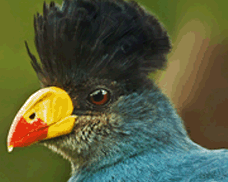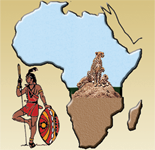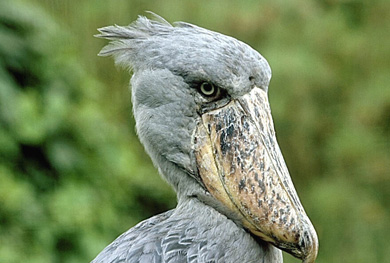11 Days Uganda Birding Safari
fromBest Bird Guides
Birdlife and Wildlife Game Drives
Parks to Visit
Kibale National Park
Queen Elizabeth National Park
Bwindi National Park
Lake Mburo National Park
-
Reviews 0 Reviews0/5
-
Vacation Style Holiday Type
-
Activity Level
-
11 Days Uganda Birding Safari
 Uganda, a small country straddling the Equator, is one of the wildlife gems of the African Continent. With over 1000 species recorded, it has the highest concentration of birds in Africa and is the most accessible place to see the legendary Shoebill, one of the world’s most bizarre birds. The misty peaks and fern-laden forests of the Bwindi Impenetrable National Park – Uganda’s birding hotspot – are an apt setting in which to search for a host of Central African forest species, including many regional specialities and some exciting endemics. These mountains also offer what is perhaps the greatest of all wildlife experiences on Earth: the opportunity to come face to face with one of man’s closest living relatives – the Mountain Gorilla – in its natural habitat.
Uganda, a small country straddling the Equator, is one of the wildlife gems of the African Continent. With over 1000 species recorded, it has the highest concentration of birds in Africa and is the most accessible place to see the legendary Shoebill, one of the world’s most bizarre birds. The misty peaks and fern-laden forests of the Bwindi Impenetrable National Park – Uganda’s birding hotspot – are an apt setting in which to search for a host of Central African forest species, including many regional specialities and some exciting endemics. These mountains also offer what is perhaps the greatest of all wildlife experiences on Earth: the opportunity to come face to face with one of man’s closest living relatives – the Mountain Gorilla – in its natural habitat.
NOTE: Gorilla trekking is optional. Permits are strictly limited in number and issued on a first-come, first served basis. Once the daily quota is sold, no further permits are available. Early booking is strongly advised!
Day 1: Arrival Entebbe
Take a flight from any Europe destination to Entebbe Airport in Uganda, arriving there this evening. You’ll be welcomed by Joseph on arrival at Entebbe and transfer directly to your hotel, for a two-night stay in Entebbe.
Day 2: Entebbe
Our birding begins this morning in the vicinity of Entebbe, where we can expect to encounter a great diversity of wetland and forest-edge birds. The diversity is astounding and we can expect to see well over eighty species today. Enormous Black-and-white-casqued Hornbills fly between the larger trees and those two unmistakable raptors, Palm-nut Vulture and Long-crested Eagle, can usually be found around town. Eastern Grey Plantain-eaters cackle from the trees and we might even find Grey Parrot. Pink-backed Pelican, Slender-billed Weaver and Pied Kingfisher are just a few of the waterside birds we should come across and the lovely African Hobby regularly hunts in the area of our hotel. Night Entebbe.
Day 3: Boat Trip for Shoebills at Mabamba Swamp, To Kibale
This morning we’ll head to nearby Mabamba Swamp. Here we will charter dug-out canoes and head deep into the papyrus swamps in search of the one bird which epitomises Uganda – the enigmatic Shoebill. Swamp Flycatchers and Malachite Kingfishers fly up as we head along the narrow channels and Black Crakes scurry about the edges of the reeds. If we are lucky, we will encounter a lone Shoebill, standing grey and silent, unmoving with its steely glare, on the edge of one of the waterways. Blue-breasted Bee-eaters hawk overhead and we should also be treated to a fine array of herons.
After lunch, we leave Entebbe and head towards Kibale National Park, making stops along the way to look for species such as Grey Kestrel and the enormous Great Blue Turaco. Late afternoon arrival in the Fort Portal area, in time to see the Ruwenzori Mountains looming on the horizon and to look for our first of the forest specialities at the start of a two-night stay. Night near Kibale National Park.
Day 4: Kibale National Park
Kibale National Park has the highest diversity of primates of any forest in the world and we hope to encounter at least a few of these monkeys today. Species we should see include Guereza Colobus, Red-tailed Monkey, Blue Monkey and Grey-cheeked Mangabey, along with Ugandan Red Colobus, if we are lucky. Of particular excitement, however, Kibale is one of the best spots in Uganda to see Chimpanzees and we will be joining a special Chimp-tracking walk here to maximise our chances of seeing them.
Kibale’s trails are well maintained and flutter with butterflies of a myriad striking colours. The birding is very rich and specialities in the park include Yellow-billed Barbet and Cassin’s Flycatcher. Flocks of noisy Grey Parrots greet the dawn as we watch for the likes of African Emerald Cuckoo, Black-billed and Great Blue Turacos, Narina Trogon, Hairy-breasted Barbet and Lühder’s Bush-shrike – we might even spot the scarce Afep Pigeon sitting out here in the early morning. The forest edge holds species such as White-throated Bee-eater, Red-headed Bluebill, Snowy-crowned Robin-chat, Little Greenbul and Western Citril. Night near Kibale National Park.
Though we have been successful seeing Chimps on all our previous tours, please note that success can never be guaranteed with these highly mobile, wary and intelligent creatures as they are not so habituated as the Gorillas we shall be looking for later on this tour.
Day 5: Kibale, To Queen Elizabeth National Park
We’ll spend the morning watching for birds and primates around Kibale. In the late morning, we make the drive to Queen Elizabeth National Park – renowned as having the second highest bird list of any park on the African continent. As we enter we’ll immediately start to see large mammals such as African Buffalo, Common Warthog, Ugandan Kob, Banded Mongoose and perhaps even African Elephant.
For our two-night stay in the park, we’ll be based at the Mweya Lodge, strategically situated on a high peninsula overlooking Lake Edward and the Kazinga Channel. There’s no better way to get familiar with some of these birds than to have them in close proximity to the lodge; last year we recorded about 60 species in a short post-breakfast walk around the lodge – mind you, that did count the Slender-billed Weavers that were almost as intent on our breakfast as we were! Night at Mweya Lodge, QENP.
Day 6: Queen Elizabeth National Park
The open country habitat in Queen Elizabeth National Park provides a good foil to our forest birding yesterday, with opportunities to look for species such as African White-backed Vulture, Martial Eagle, Black-bellied Bustard, Red-necked Francolin, Sulphur-breasted Bush-shrike, Black-headed Gonolek, Stout and Trilling Cisticolas, Rüppell’s Glossy Starling and Red-chested Sunbird. At night, Hippos feed on the lawns of the lodge.
For most visitors to the Park, however, the highlight of their visit will be a boat trip on the Kasinga Channel, which bisects the park as it flows between Lakes Edward and George. Birds are abundant and from our launch we should enjoy a fine array of wetland species – from Goliath Heron, Yellow-billed Stork and Sacred Ibis to Water Thick-knee, Plain Martin and the peculiar African Skimmer – while the fringing vegetation is also home to the gaudy Papyrus Gonolek. Snorting Hippos are numerous and other mammals to watch for beside the Channel include African Elephant, African Buffalo and Marsh Mongoose. Most unusual of all – if we’re really lucky – is the Giant Forest Hog; in fact, the Queen Elizabeth National Park is the best place in Africa to see it. Night at Mweya Lodge, QENP.
Days 7 – 9: Bwindi Impenetrable Forest: Gorillas & Forest Birds
After wending our way slowly south through Queen Elizabeth National Park in the afternoon we should arrive at our next destination, Buhoma – the main gorilla-tracking base for the Bwindi Impenetrable National Park. Our lodgings here are another treat in store, for our accommodation is an upmarket camp with spectacular views over the adjacent forests of the Bwindi National Park.
Nestled in the Kigezi uplands, Bwindi is arguably Uganda’s prime birding area. Spanning an unbroken swathe of forest, from the lowlands at Buhoma to the lofty highlands at Ruhiza, and stretching away towards the Congo border, we are assured of a truly memorable few days. Here, pitta-like Short-tailed Warblers skulking in the mossy undergrowth will prove distracting while tracking Mountain Gorillas, Grey Parrots squawk overhead and groups of Chimpanzees shriek from deep within the forest. Black-faced Rufous Warblers call from the forest edge and Red-throated Alethes lurk in the hidden depths, while gorgeous Black and Cinnamon-chested Bee-eaters, Black-and-white Flycatchers and Narrow-tailed Starlings frequent the verdant canopy. The bird list here is both long and alluring and others we may see include Cassin’s Hawk-eagle, Yellow-rumped Tinkerbird, Elliot’s Woodpecker, Blue-throated Roller, Red-tailed Greenbul, Equatorial Akalat and Chestnut Wattle-eye.
During our stay in the Park, those who have booked to take the Gorilla trekking option will be able to join a small party led by one of the Park’s specialist tracker-guides in a quest to find these wonderful creatures. Treks can involve spending between three and ten hours in the field (depending on where the animals happen to be feeding in relation to the camp); the going can be strenuous at times, and the terrain is steep and rough – but if successful, the rewards are immense, for a close encounter with this ‘gentle giant’ ape is an experience never to be forgotten!
Please note that the number of Gorilla permits is strictly limited and these are issued on a first come, first served basis, which means permits must be requested and paid for in advance to be sure of securing one. We will of course hope to all do our Gorilla-trekking on the same day, but we might possibly have to split up on different days depending upon numbers and the availability of permits, which are controlled by the park authorities. Three nights at Buhoma, Bwindi Impenetrable National Park.
Day 10: Bwindi to Lake Mburo National Park
Bidding a reluctant farewell to the Impenetrable Forest, we head back east and stay one night amid the savanna on the edge of Lake Mburo National Park. We could well encounter a range of new species here, including the characterful Bare-faced Go-away-bird, Crested Francolin, Black-bellied Bustard, Rufous-chested Swallow, Red-headed Lovebird and perhaps the rare Red-faced Barbet, if we are lucky. Raptors are excellent and five species of vulture have been recorded. Night at Lake Mburo National Park.
Day 11: Lake Mburo National Park To Entebbe
After enjoying some final birding in the savanna at Lake Mburo National Park, sadly we must make the journey back to Entebbe. Arriving at Entebbe, we’ll enjoy a farewell meal this evening prior to returning to the airport for our British Airways overnight flight home.

